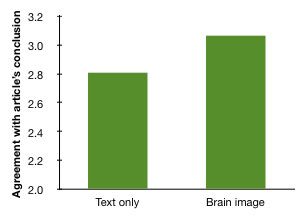Brain Image Bias
 The use of brain imaging in evaluating advertising and products is increasing, and one wonders if the judgment of marketing execs could be clouded by the presence of colorful scan images when used to back up humdrum conclusions in the text. The answer is almost certainly, “Yes.” A recent study showed that students found studies more believable when accompanied by brain images – even when those images added no information to the text content. Cognitive Daily reports on several studies which used both invented and real studies to test the effect of brain images on credibility:
The use of brain imaging in evaluating advertising and products is increasing, and one wonders if the judgment of marketing execs could be clouded by the presence of colorful scan images when used to back up humdrum conclusions in the text. The answer is almost certainly, “Yes.” A recent study showed that students found studies more believable when accompanied by brain images – even when those images added no information to the text content. Cognitive Daily reports on several studies which used both invented and real studies to test the effect of brain images on credibility:
The agreement with the article’s conclusion was significantly higher when a brain image was presented, even though the same evidence was presented in textual form in the article, making the brain image redundant. Even more striking, while agreement with the conclusion was affected by the presence of the brain image, the presence or absence of substantive criticism had no effect. Criticism did have an effect on whether the students thought the article title (“Brain scans can detect criminals”) was appropriate. [From Cognitive Daily – What’s more convincing than talking about brains? Pictures of brains! by Dave Munger.]
It seems that the presence of brain scans boosts the credibility of study information in every case. (Original study by McCabe and Castel here.) I guess we shouldn’t be too surprised – we know that trust and believability can be influenced by many factors. One interesting study that relates not to scientific study data but to websites is the Stanford Web Credibility Project. The Stanford research has shown that a variety of factors influence website credibility, including things like showing the people behind the website, providing citations or other third party support for any claims, and so on. It’s not difficult to imagine that brain images are just one of multiple factors that could boost the credibility of a study. I’d imagine that posting a prominent bio of the lead researchers, including prestigious affiliations, awards, and so on would have a positive effect, even if the data itself was the same.
In commenting on Munger’s post in fMRI Images Bias Brain, Jonah Lehrer suggest that the experiments be repeated with neuroscientists as the subjects, to see if they, too, are influenced by scan images.
Munger closes his post with the thought,
Given the power of the brain image to sway opinion, perhaps it will only be a matter of time before we start seeing brain images in advertising.
That would certainly be an ironic twist… perhaps an playful researcher with a neuromarketing bent could use fMRI scans to judge the effect of an ad containing… fMRI scans.

